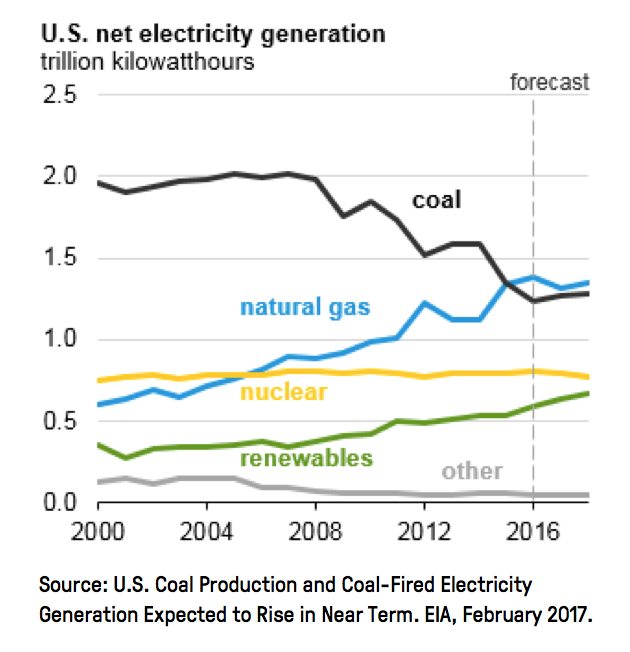By Jared Solomon, intern, in collaboration with Jennifer Kefer, Vice President of David Gardiner and Associates and Executive Director of the Alliance for Industrial Efficiency
Over the past decade, coal and nuclear-based energy production has declined or stagnated, replaced by quickly rising natural gas production and steady (but less rapid) adoption of renewable energy. Despite concerns that the decline of easy-to-store energy sources like coal and nuclear power could compromise the integrity of the grid, especially in the case of emergency events, studies have largely disproved this idea. In fact, the U.S. Department of Energy recently determined that the grid’s reliability has not been compromised by the retirement of aging coal and nuclear plants. And if grid reliability were a concern, propping up coal would not be the way to resolve it.
 In a move seemingly incongruous with such a finding, the DOE issued a Notice of Proposed Rulemaking (NOPR) to the Federal Energy Regulatory Commission (FERC) in October proposing a rule to force utilities to pay for coal and nuclear power plants to stockpile 90 days worth of fuel onsite, essentially guaranteeing profits for these power plants and artificially propping up coal and nuclear markets. The Alliance for Industrial Efficiency filed official comments on this NOPR upon its release, arguing that in the case of favorable pricing changes for coal and nuclear energy in the name of grid reliability, combined heat and power (CHP) technology should also receive favorable pricing and benefits due to its ability to create extremely resilient energy systems and proven track record during natural disasters.
In a move seemingly incongruous with such a finding, the DOE issued a Notice of Proposed Rulemaking (NOPR) to the Federal Energy Regulatory Commission (FERC) in October proposing a rule to force utilities to pay for coal and nuclear power plants to stockpile 90 days worth of fuel onsite, essentially guaranteeing profits for these power plants and artificially propping up coal and nuclear markets. The Alliance for Industrial Efficiency filed official comments on this NOPR upon its release, arguing that in the case of favorable pricing changes for coal and nuclear energy in the name of grid reliability, combined heat and power (CHP) technology should also receive favorable pricing and benefits due to its ability to create extremely resilient energy systems and proven track record during natural disasters.
Early this week, FERC rejected the NOPR. While FERC highlighted the lack of evidence that current electricity trends threaten grid resiliency, the Commission also acknowledged the importance of resiliency and subsequently initiated an exploration of its modern definition and potential contributors. The Alliance for Industrial Efficiency wholeheartedly supports this approach and would like to take advantage of this spotlight on resiliency to once more highlight the relevant benefits of CHP.
The federal government previously defined resilience as “the ability to prepare for and adapt to changing conditions and withstand and recover rapidly from disruptions. Resilience includes the ability to withstand and recover from deliberate attacks, accidents, or naturally occurring threats or incidents.” This definition describes many of CHP’s benefits – namely, its ability to maintain power under changing and disruptive environmental conditions.
Initially, the Alliance made three main points about the superiority of CHP:
- Below-ground infrastructure is more reliable than the above-ground power lines that transport nuclear and coal-fired energy. While these above-ground lines can be destroyed in storm events, below-ground pipelines that transport the natural gas that runs most CHP systems are far less vulnerable. Moreover, some non-CHP systems can go down due to single points in the system being affected, easily causing substantial power outages across the grid. CHP, meanwhile, allows buildings to remove themselves from the grid and remain functional during blackouts that would otherwise affect them.
- CHP is highly reliable. According to the US Environmental Protection Agency, most CHP technologies have greater than a 95% reliability rate. That means that a CHP system will stay up and running if it’s designed to do so.
- CHP has demonstrated its abilities time and time again in the face of natural disasters. Hospitals nationwide have used CHP to keep their lights on and save lives during hurricanes, with some notable examples being the Texas Medical Center (the largest medical complex in the world), which kept the power on during Hurricane Harvey and Long Island’s South Oak hospital, which operated off the grid for 15 days during Hurricane Sandy.
CHP’s benefits are not limited to hospitals, but can be installed in any building that uses large amount of thermal energy and electricity – i.e. most commercial and industrial buildings. During Hurricane Sandy, New York University was able to use its CHP system to keep power in its core campus while much of lower Manhattan experienced a blackout.
While the DOE’s 2017 proposal operated under a misguided notion of grid reliability and resilience, the NOPR began an important conversation on the future of our nation’s energy systems. Any program to increase energy reliability and avoid outages in the face of extreme and disruptive events would be incomplete without incentives to promote the use of combined heat and power technology.
You can access the Alliance’s full comments here.
